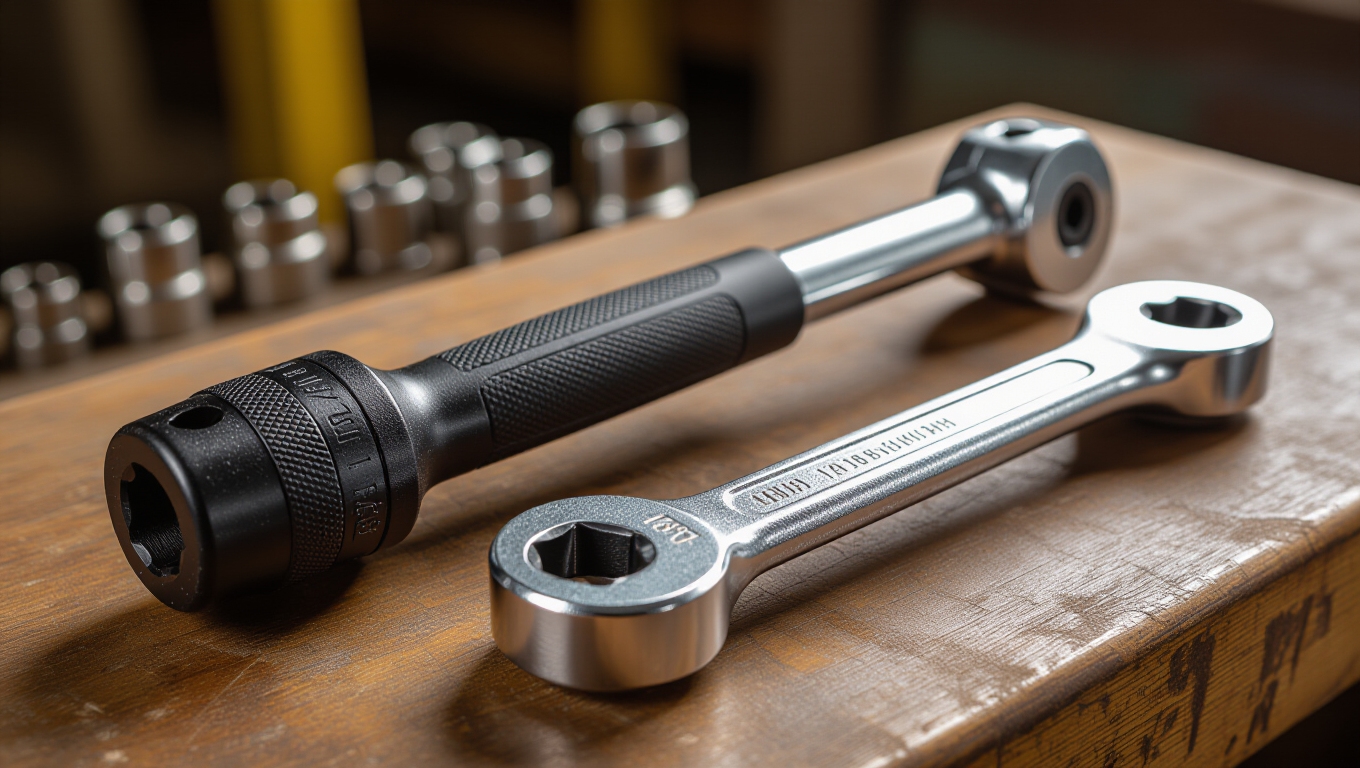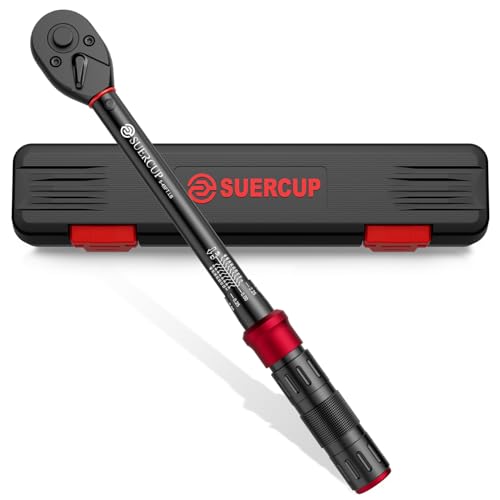You’ll want a 3/8-inch torque wrench for light-duty, precise tasks with torque needs from 15 to 75 ft-lbs, especially in tight spaces where maneuverability matters. A 1/2-inch wrench packs more power, handling 30 to 250+ ft-lbs for heavy-duty jobs like lug nuts or suspension work, though it’s bulkier. Your choice depends on torque requirements, workspace access, and durability. Understanding these factors helps optimize tool performance and task efficiency.
Key Takeaways
- 3/8-inch torque wrenches handle 15-75 ft-lbs, ideal for light-duty, precision tasks and tight spaces.
- 1/2-inch torque wrenches cover 30-250+ ft-lbs, suited for heavy-duty applications and larger fasteners.
- 3/8-inch wrenches are compact, lightweight, and maneuverable in confined areas, reducing user fatigue.
- 1/2-inch wrenches offer greater durability, stronger build, and longer calibration retention for demanding jobs.
- Socket compatibility differs: 3/8-inch fits smaller sockets, 1/2-inch fits larger ones, affecting versatility and application range.
1/2 vs 3/8 Torque Wrench Comparson Table:
| Feature | 3/8″ Torque Wrench | 1/2″ Torque Wrench |
|---|---|---|
| Torque Range | 15–75 ft-lbs | 30–250+ ft-lbs |
| Ideal Use | Light-duty, precision tasks in tight spaces (small fasteners, engine work, motorcycles) | Heavy-duty jobs requiring more power (wheel lug nuts, suspension, engine components) |
| Size & Maneuverability | Compact and lightweight; excels in confined or overhead spaces | Bulkier and heavier; better leverage for tough fasteners, less maneuverable |
| Durability & Build | Simpler design; can wear faster at high torque levels | Engineered for strength, uses robust materials for lasting durability |
| Socket Compatibility | 3/8″ drive sockets; suits fasteners below 17mm | 1/2″ drive sockets; best for fasterers 17mm and above |
| Ergonomics | Reduces fatigue on small jobs; easier in tight spots | Enhanced stability and force for demanding work; can cause quicker fatigue in longer use |
| Accessory Support | Suits lighter, precision-oriented accessories; adapters available but can increase wear | Pairs with heavy-duty, impact-rated accessories commonly used in professional work |
| Cost & Value | Lower initial cost; good for budget or occasional use | Higher cost but better long-term value and versatility for frequent heavy use |
| Calibration Needs | May drift sooner if pushed to max; recalibrate every 12 months or 5,000 uses | Retains calibration longer; recommended same intervals but copes better under stress |
| Best For | Precision work, DIY, light repairs | High-torque needs, automotive, construction |
Torque Range Differences
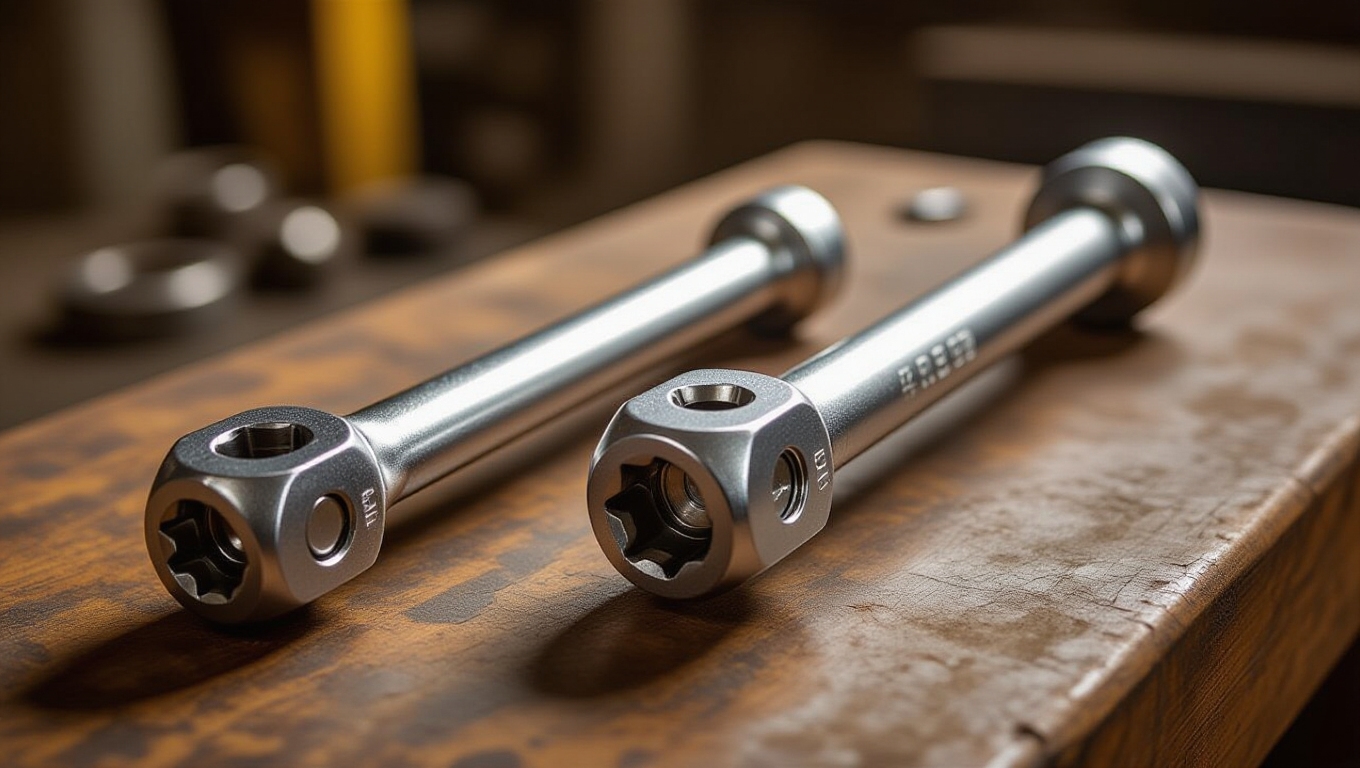
When selecting between a 3/8-inch and a 1/2-inch torque wrench, you need to contemplate their torque range specifications carefully, as they directly impact the suitability for your task.
The 3/8-inch wrench typically covers 15 to 75 ft-lbs, ideal for lighter, precision tasks involving smaller fasteners. This size is also favored for automotive repair and DIY projects due to its lighter weight and compact design. It is important to match the wrench size with the recommended torque range for specific fasteners to avoid damage.
In contrast, the 1/2-inch wrench spans roughly 30 to 250 ft-lbs, accommodating medium to heavy-duty applications like lug nuts and engine components.
This broader range allows you to handle higher torque requirements safely without risking under- or over-tightening.
Although their torque ranges overlap, the 1/2-inch drive’s superior upper limit provides better durability and versatility for demanding jobs.
Selecting the correct torque range ensures accuracy, prevents fastener damage, and maintains mechanical integrity in your work.
Comparing Size and Weight for Practical Use
Although both 3/8-inch and 1/2-inch torque wrenches serve essential roles, their size and weight differences considerably affect practical usability. The 3/8-inch wrench’s compact design allows you to work efficiently in tight spaces, such as confined engine bays or small machinery components, while its lighter weight reduces fatigue during extended use or overhead tasks.
It is typically used for lower torque ranges, up to about 150 ft-lbs, making it ideal for precision work. Regular maintenance and proper use ensure these tools perform reliably, much like the importance of filter maintenance in engine care.
In contrast, the 1/2-inch wrench, being bulkier and heavier, provides greater leverage for higher torque applications but may hinder maneuverability in restricted areas. This added weight enhances stability and force application on tougher fasteners, though it might tire you faster.
Ultimately, your choice hinges on task requirements: select the 3/8-inch for precision, accessibility, and portability, and opt for the 1/2-inch when handling heavier-duty jobs demanding more torque and robustness.
Durability and Build Quality Analysis
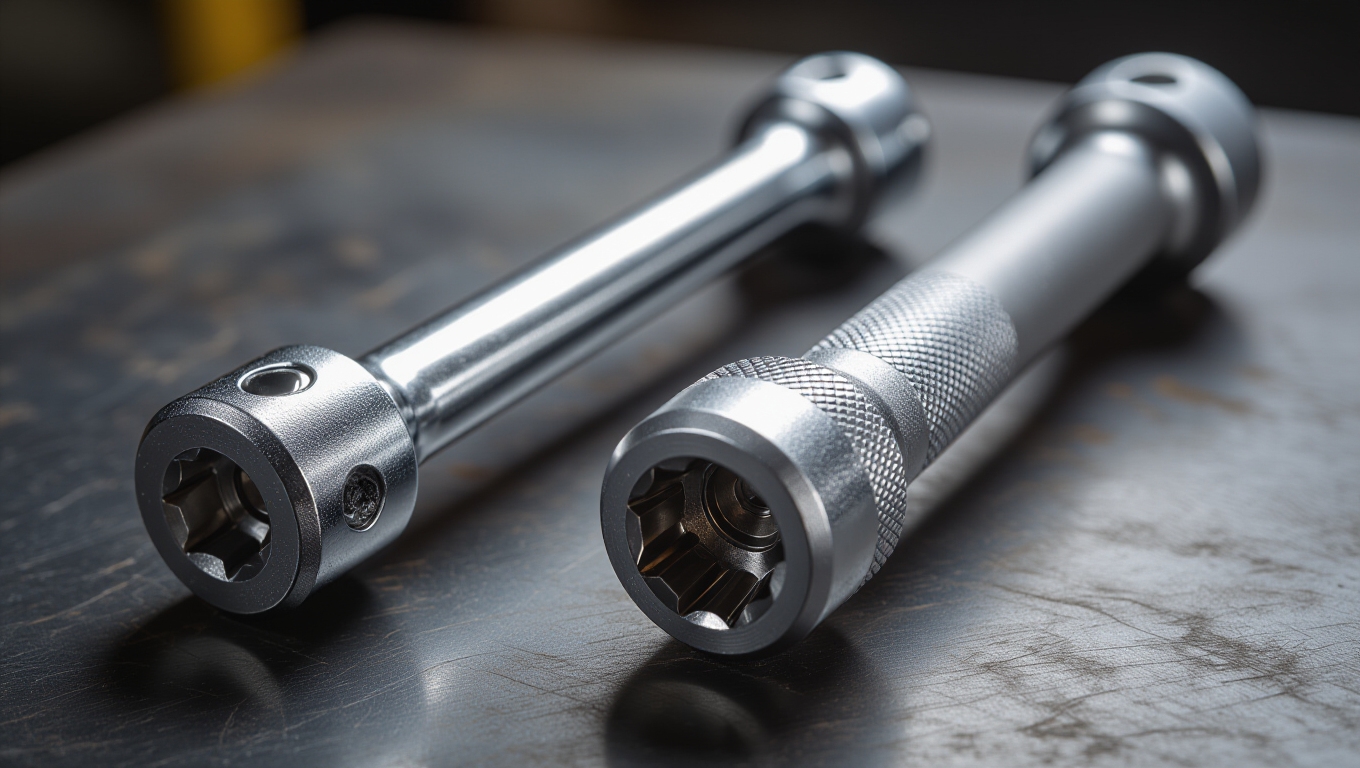
Size and weight play a significant role in torque wrench usability, but evaluating durability and build quality reveals deeper insights into long-term performance and reliability. Like the CK Series control arms, which are praised for their long-lasting performance, the 1/2-inch torque wrench is engineered for extended durability.
The 1/2-inch torque wrench uses stronger alloys and heavier-duty components, ensuring robustness under high torque loads and frequent use. Its larger, thicker gears and reinforced ratchets resist wear and mechanical fatigue better than the lighter, compact 3/8-inch models, which often employ simpler internal designs with less reinforcement.
Additionally, the drive size correlates with torque range and application complexity, which influences the choice of materials and build quality.
You’ll find 1/2-inch wrenches maintain calibration longer due to superior springs and ratchets, while 3/8-inch wrenches risk faster calibration drift and ratchet tooth wear when pushed near their torque limits.
Ergonomically, 1/2-inch handles reduce slippage and deformation, supporting durability under heavy stress, whereas 3/8-inch builds prioritize compactness at some cost to long-term toughness. Regular maintenance, similar to servicing ball joints with grease fittings in premium control arms, can also extend the lifespan of torque wrenches.
Socket Compatibility and Versatility Factors
You need to take into account socket size compatibility when choosing between 3/8-inch and 1/2-inch torque wrenches, as each supports different fastener ranges and task requirements. The 3/8-inch wrench excels in lighter, more compact applications. The 1/2-inch model handles heavier-duty tasks with larger fasteners.
Selecting the right tool also depends on the material strength of the fasteners you plan to work with. Understanding these versatility factors ensures you select the right tool for your specific workload and socket inventory. Additionally, the choice between these sizes influences the maximum torque capacity you can achieve, with 1/2-inch drives typically offering significantly higher torque output.
Socket Size Compatibility
How do you determine the right socket size for your torque wrench? Start by matching the wrench’s drive size to the socket’s square fitting: 3/8-inch wrenches fit 3/8-inch sockets, and 1/2-inch wrenches fit 1/2-inch sockets.
The 3/8-inch sockets suit small to medium fasteners, usually under 17mm, while 1/2-inch sockets handle medium to large fasteners, 17mm and above.
Using sockets mismatched to torque capacity risks damage; smaller 3/8-inch sockets can’t reliably withstand the higher torque of 1/2-inch wrenches. Although adapters exist, they add stress and reduce socket life. Choosing the appropriate tool also ensures durability and performance during use.
Additionally, 3/8-inch sockets offer lighter weight and better maneuverability in tight spaces, whereas 1/2-inch sockets provide robustness for heavy-duty applications. It’s also important to consider that 3/8-inch impact wrenches typically operate on lower voltage batteries like 12V or 18V, making them more portable for medium-duty work.
Therefore, socket size compatibility hinges on drive size, fastener dimension, and torque requirements.
Versatility Across Applications
Although both 3/8″ and 1/2″ torque wrenches serve critical roles, their versatility across applications hinges on torque range, handling characteristics, and accessory compatibility. You’ll find 3/8″ wrenches excel in precision and confined spaces, ideal for moderate torque tasks, while 1/2″ wrenches handle heavy-duty jobs demanding higher torque and stability.
Accessory compatibility also drives versatility; 1/2″ supports more robust extensions and adapters suited for industrial work, whereas 3/8″ accessories favor delicate applications. Choosing the right tool requires balancing performance goals with practical application needs.
| Feature | 3/8″ Torque Wrench | 1/2″ Torque Wrench |
|---|---|---|
| Torque Range | 15–75 ft-lbs | 50–250+ ft-lbs |
| Handling | Lightweight, tight spaces | Heavier, stable on large fasteners |
| Accessory Support | Lighter, precision-oriented accessories | Heavy-duty, impact-rated accessories |
Ideal Applications for Each Torque Wrench Size
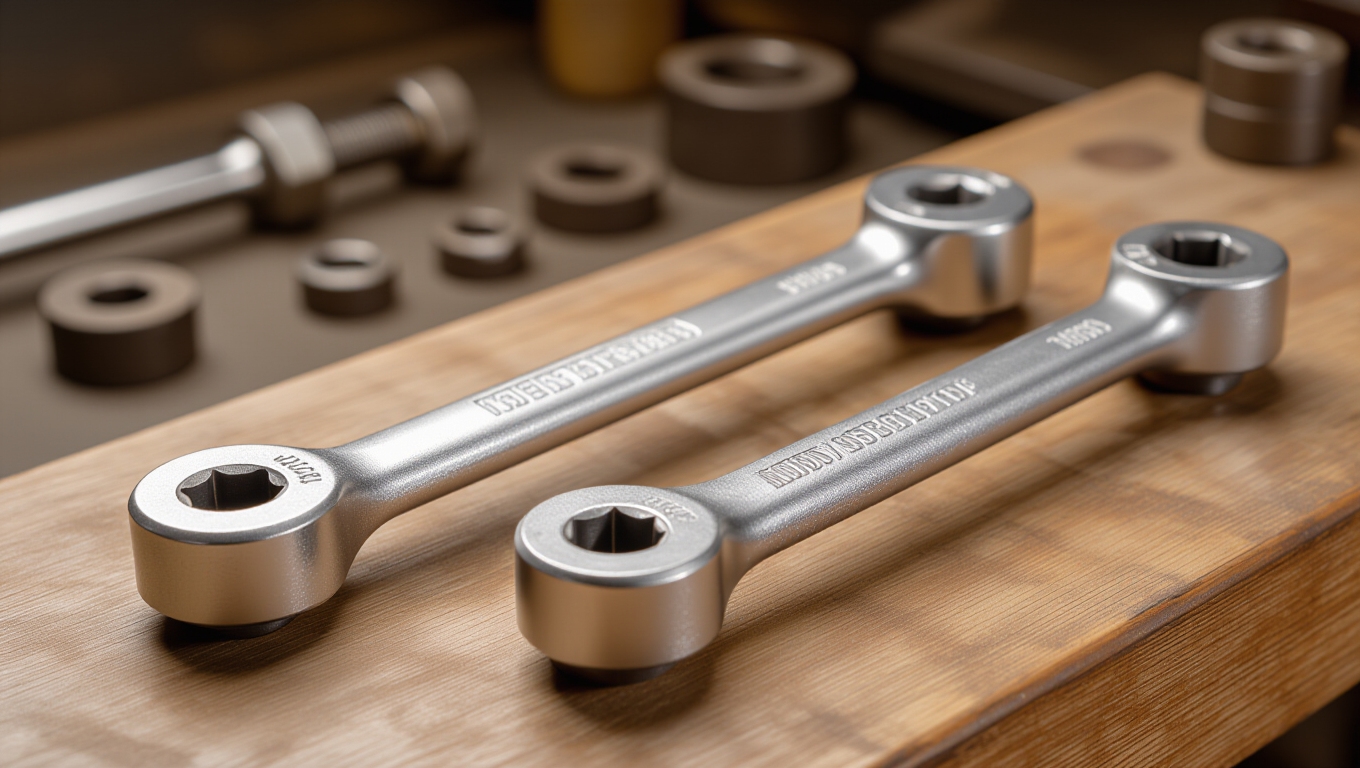
You’ll want a 3/8-inch torque wrench for light-duty tasks where precision and maneuverability in tight spaces matter most. This size is often preferred when working with budget-friendly tools that still offer reliable performance.
When dealing with heavy-duty applications requiring higher torque, a 1/2-inch wrench provides the necessary strength and durability.
Choosing the right size hinges on balancing the torque range with control and accessibility for your specific job. Typically, the 3/8 drive covers a torque range of 15-75 ft-lb, making it the most versatile option for many automotive and mechanical tasks.
Light-Duty Vs Heavy-Duty
When selecting between a 3/8-inch and a 1/2-inch torque wrench, consider the torque requirements and job complexity. The 3/8-inch excels in light-duty tasks, offering 15-75 ft-lbs torque range, ideal for smaller bolts and confined spaces.
The 1/2-inch covers 30-250 ft-lbs, suited for medium to heavy-duty automotive work like lug nuts and engine components. For heavier tasks such as suspension or axle nut work, the 1/2-inch torque wrench is preferred due to its higher torque capacity. Understanding the specific needs of your task is crucial, much like choosing the right engine oil formulation for optimal performance.
| Torque Wrench Size | Ideal Use Cases |
|---|---|
| 3/8-inch | Motorcycles, small parts, light repairs |
| 1/2-inch | Wheel lug nuts, timing belts, engine fasteners |
Choose 3/8-inch for precision in tight spots; select 1/2-inch when higher torque and durability are pivotal for demanding tasks.
Precision and Maneuverability
Since precision and maneuverability directly impact the effectiveness of torque application, choosing the right wrench size is essential based on your task’s spatial constraints and torque requirements.
A 3/8-inch torque wrench excels in confined spaces due to its compact head and lightweight design, allowing you to apply precise torque (15–75 ft-lbs) on small fasteners without over-tightening. It’s ideal for intricate automotive, motorcycle, and electronics work where maneuverability and fine control matter.
Conversely, a 1/2-inch torque wrench offers greater leverage and stability for higher torque demands (30–250 ft-lbs), suited for larger fasteners in automotive suspension, tire, and heavy machinery tasks. Though bulkier, it provides the necessary force where precision yields to power, with less suitability for tight or complex assemblies.
Select based on balancing your need for accuracy versus torque capacity and access. Proper maintenance and timely replacement, similar to maintenance routines in other precision tools, are crucial for optimal performance and longevity.
Maneuverability in Tight or Confined Spaces
Although torque wrenches vary widely in size and torque capacity, choosing the right drive size considerably impacts your ability to work efficiently in tight or confined spaces.
Selecting the correct drive size is key to efficient torque wrench use in tight, confined spaces.
A 3/8-inch drive torque wrench, being more compact, offers superior maneuverability around smaller nuts and bolts typical in automotive repairs. Its shorter length and ergonomic ratchet head reduce repositioning, which is vital when access is limited. Selecting tools with proper fitment ensures optimal performance and durability.
In contrast, 1/2-inch drive wrenches, generally longer and bulkier, restrict movement in enclosed areas despite delivering higher torque. Using tools with proper torque application helps prevent component damage, especially when working in restricted spaces.
Low-profile and slim-head designs further enhance access, especially in blind corners or narrow openings.
When working in cramped environments, prioritizing a smaller drive size like 3/8-inch balances torque capacity with spatial constraints, ensuring precise application without compromising your ability to navigate confined spaces effectively.
Cost Implications and Value Considerations
While selecting between 3/8-inch and 1/2-inch torque wrenches, you must weigh cost implications against value considerations to optimize your investment. The 3/8-inch models offer lower initial purchase and maintenance costs, aligning well with existing toolsets and tight budgets. However, it is important to remember that calibration and verification are crucial to maintain accuracy, especially with frequent use.
However, 1/2-inch wrenches, despite higher upfront and replacement costs, provide superior durability and a broader torque range, enhancing versatility for heavy-duty tasks. Precision and brand reputation further influence value, with premium models in both sizes delivering increased accuracy.
Economically, investing in a 1/2-inch wrench yields better long-term ROI and time efficiency for frequent, high-torque applications. Ultimately, your decision should balance upfront expenses against operational efficiency, tool longevity, and task requirements to maximize economic efficiency and minimize risk.
Choosing the Right Torque Wrench for Your Needs
Balancing cost and value sets the stage for selecting a torque wrench that fits your specific needs. First, assess the torque range your tasks demand: use a 3/8-inch wrench for 10-50 Nm jobs requiring precision on smaller fasteners, like automotive engine components. For heavier applications exceeding 40 Nm, a 1/2-inch wrench offers the necessary leverage and durability up to 200+ Nm.
Avoid operating tools near their torque limits to maintain accuracy, ideally working within 20-80% of their rating. It is also important to consider the torque requirements to ensure the wrench is suitable for your application.
Consider ergonomics—choose lighter 3/8-inch wrenches for tight spaces and repetitive tasks, or 1/2-inch models with longer handles for high-torque efforts. Finally, factor in accessory compatibility and calibration needs to guarantee long-term precision and versatility across your projects.
Frequently Asked Questions
How Often Should I Calibrate My Torque Wrench?
You should calibrate your torque wrench at least every 12 months or after 5,000 uses, whichever comes first.
If you work in high-risk industries or use the tool intensively, consider calibrating every six months or 2,500 cycles.
Always recalibrate immediately if the wrench fails a test or has been stored long-term.
Adjust intervals based on environmental exposure, load intensity, and precision needs to maintain accuracy and compliance.
Can I Use a Torque Wrench for Impact Applications?
You shouldn’t use a torque wrench for impact applications. Torque wrenches are precision tools calibrated for controlled torque, not sudden bursts typical of impact tools.
Applying impact forces can damage their internal mechanisms, ruining accuracy and risking tool failure. Instead, use impact wrenches designed to handle high-torque bursts safely.
Mixing these tools jeopardizes joint integrity, voids warranties, and increases maintenance costs. Always match tools to their intended use for safety and precision.
What Is the Typical Lifespan of a 3/8-Inch Torque Wrench?
You can expect a 3/8-inch torque wrench to last between 5,000 and 10,000 cycles before needing recalibration.
ISO 6789 advises recalibrating every 5,000 uses or 12 months, but if you require high precision, calibrate more frequently—around 2,500 to 3,000 uses.
Proper storage at the lowest torque setting and regular maintenance help maintain accuracy and extend lifespan, preventing mechanical wear and ensuring reliable torque application.
Are There Digital Versions of 3/8 and 1/2 Torque Wrenches?
Yes, you’ll find digital versions of both 3/8″ and 1/2″ torque wrenches readily available. These tools feature multi-unit displays, ±2-3% accuracy, and target alerts via vibration, buzzer, or LED.
The 3/8″ models suit precision tasks, while 1/2″ variants handle higher torque ranges for larger jobs.
Both often include hardened steel construction, battery power, and meet ASME standards, ensuring durability and reliable calibration for professional use.
How Do Temperature Changes Affect Torque Wrench Accuracy?
You’ll find that temperature changes impact torque wrench accuracy by altering internal lubricant behavior and metal expansion. Cold can freeze grease and cause rust, lowering precision, while heat above 120°F melts lubricants and degrades performance.
Metal parts expand or contract, shifting calibration slightly. To maintain accuracy, keep your wrench between 40°F and 110°F, store it properly, and calibrate more frequently when exposed to extreme or fluctuating temperatures.
Turn Every Bolt with Confidence—Select Your Perfect Torque Wrench
Choosing between a 3/8 and 1/2 torque wrench is like selecting the right key for a lock—each fits a specific purpose with precision. The 3/8 is your nimble locksmith, perfect for delicate, confined spaces, while the 1/2 acts as the heavy-duty master key, delivering higher torque where strength is essential. By understanding their ranges, sizes, and applications, you guarantee your wrench turns every bolt with exactitude, avoiding damage and maximizing efficiency.

